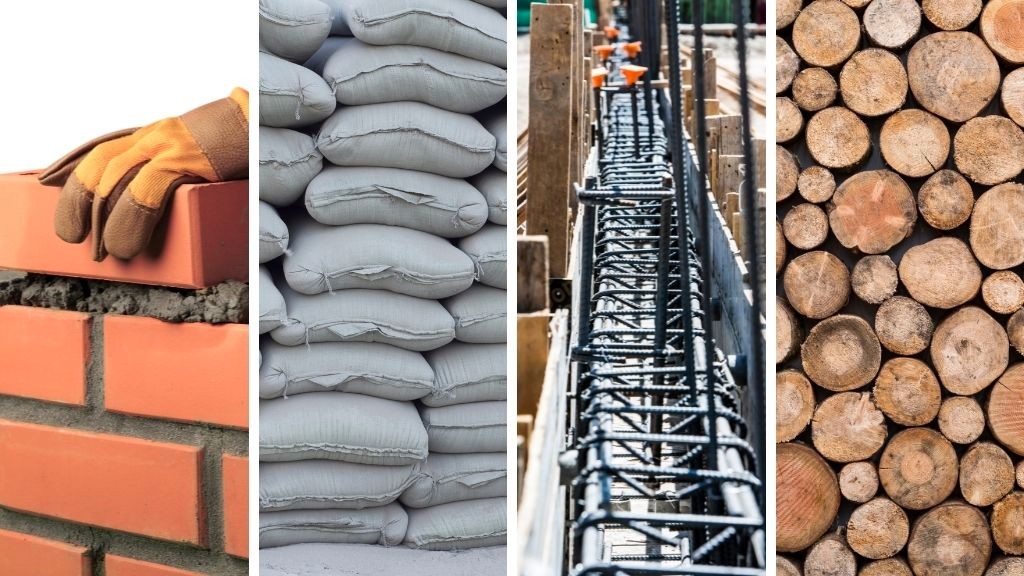50+ Construction Materials List With Images & Uses

Construction materials play an essential role in the design, construction and maintenance of any civil engineering structure. Therefore, it is necessary to understand that the nature of construction materials determines a structure’s durability, longevity, strength and resistance. Following is the list of over 50 materials used for construction purposes:
- Cement: It acts as a binder, helping concrete to secure and support the large, heavy structures that make our cities possible.
- Concrete: Concrete is a composite material made from a cementitious material mixed with water, which hardens over time. It is widely used as a building material, often in combination with steel rebar or other reinforcement.
- Sand: It’s added to asphalt and concrete to make them stronger and more resistant to erosion. And it’s also a major component for pool and other kinds of rendering.
- Asphalt: Asphalt can be used in driveways or on streets throughout cities and towns across the country where there is heavy traffic from cars, trucks and buses driving over them daily.
- Bricks: They are made from clay or mud baked in an oven. Bricks are used to build houses, walls and chimneys.
- Steel: Steel can be formed into any shape and size by heating it at a high temperature and then cooling it quickly in cold water or air.
- Timber: Timber is used for structural purposes as well as for decoration. It comes in many different shapes and sizes depending on where it grows.
- Wood: Wood is used to make doors, windows, furniture, floors, cabinets, and countertops.
- Soil: Soil is cheap and readily available. Soil can be used for making bricks, concrete, blocks and even asphalt.
- Stone: Stone can be used to make bricks, stones, blocks etc.
- Plastic: Plastic can be used to make pipes, tubes, sheets etc. These are widely used in plumbing and HVAC systems of buildings.
- Bitumen: Bitumen is an asphalt-type material that is a black sticky substance obtained from coal tar or petroleum distillation. Bitumen has many uses, like road surfacing material and roofing shingles.
- Binding Wires: They are used in binding the structural steel together at different levels so that they can be held firmly in place.
- Structural Steel: It is used in the form of beams, columns, plates and bars. It has high tensile strength, good ductility and low density.
- Fly Ash: It is a byproduct of coal-fired power plants and is used as a cement replacement instead of Portland Cement to reduce carbon footprint.
- Aggregate: It is a crushed rock material that is used for making concrete or mortar.
- Blocks: They are used for making walls and floors strong enough to carry weight.
- Nails: Nails are used in construction to hold together pieces of wood.
- Lime: Lime is used as a binder for concrete, mortar and plastering materials. It is also used as a waterproofing agent for swimming pools and other water-repelling surfaces.
- Paint: Paint is used to protect and decorate buildings, bridges and other structures.
- Bamboo: Bamboo is used to make scaffolding for construction work. It is also used for making chairs, tables and cabinets.
- Pipes: Piping systems are used to transport water, oil, gas and other fluids.
- Glass: Glass is used in constructing windows, doors, skylights and fences. It is also used for mirrors and other decorative purposes.
- Tiles: Tiles are used in flooring, walling and roofing. They can also be used to make countertops and sinks.
- Marble: Marble is a type of stone often used on walls and floors because of its durability and beauty. It can also be used for decorative purposes, such as making statues or sculptures.
- Metal Sheet: Metal sheet is used for covering roofs, walls, ceilings and floors. It is also used for making doors, windows and frames.
- Mud: Mud can be used as a base for brickwork or concrete work, or it can be used as a plaster or plasterboard.
- Tar: Tar is used as a binder in concrete mixtures for making roads and pavements. It is used as an adhesive to join different materials during construction work.
- Chipboard: Made from wood chips and sawdust, Chipboard can be used to build furniture and cabinets, as well as in other applications such as flooring.
- Rope: Rope is used in construction to support heavy objects or pull them up so they can be used in different areas. It is also used to make furniture items like chairs and stools.
- Water: Water is essential to construction, allowing workers to mix cement and other materials.
- Green Cement: Green cement refers to cement without additives like limestone or clay that can help reduce carbon dioxide emissions during production by up to 50{15e6ce0c46093fe756ee6d60c9832e53071b764df8692c1814301dcc17619c7b}.
- Granite: Popular for being hard and durable, granite is used in flooring, countertops and exterior walls.
- Primer: This is a type of paint that acts as a base coat for other paints and helps prevent the paint from cracking or peeling off later on.
- Straw: Straw bales are used as building insulation, strawboard is made of straw fibers, and strawcrete is mixed with cement to make concrete blocks.
- Iron: Iron is used in construction to reinforce concrete and masonry, as girders and columns, and for roofing applications.
- White Cement: It is made from limestone and clay or shale and is used as an ingredient in concrete, mortar and plaster.
- Rubber: Rubber has many uses in construction, including roofing shingles, gaskets and seals for doors and windows, and insulation around pipes.
- Aluminum: Aluminum is an excellent exterior cladding material for residential buildings because it doesn’t corrode or rust and can be finished to look like wood or stone.
- Alloy: Alloy steel is used in structural beams in high-rise buildings because of its high strength-to-weight ratio.
- Gypsum Board: Also known as drywall, it is a building material made from gypsum, used for interior walls and ceilings in residential and commercial buildings.
- Ceramics: Ceramic materials have many applications in construction, including tile roofing, flooring, countertops and pottery vases.
- Gypsum: Gypsum is the main component of sheetrock, which is used as a sound and fireproofing material.
- The metal is used for plumbing, heating systems and electrical wiring due to its conductivity and thermal properties.
- This can be made from polystyrene, polyurethane or latex rubber and is used as insulation or a waterproof barrier.
- Clay: It is the most widely used material for making bricks, tiles and pottery.
- Carbon Fiber: With high tensile strength, stiffness, and elastic modulus, it is often used in aerospace, automotive, military, and civil engineering applications.
- Railings: These are commonly used as safety features on staircases and balconies to prevent falls.
- Planks: They are typically laid over joists or studs with drywall attached to them by nailing or gluing.
- Wire: It is used as a building material in construction projects where little weight needs to be supported, such as fences and gates

